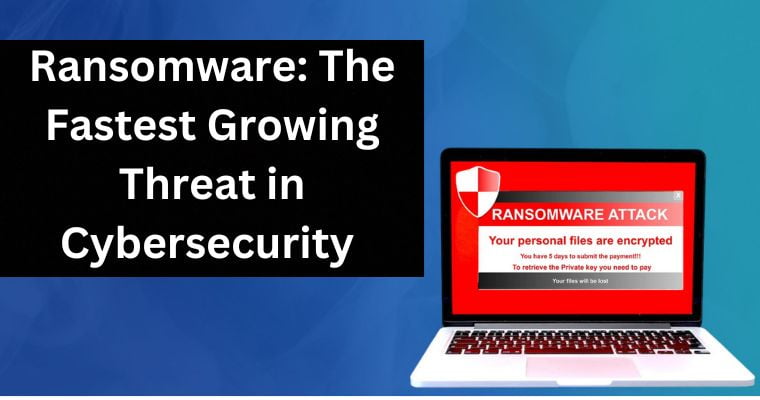Cybercriminals are increasingly employing ransomware to extort money from people and companies, making it one of the most rapidly expanding cybersecurity threats.
Due to the prevalence of internet-connected devices today, ransomware poses a serious risk. Several social engineering techniques are used by cybercriminals to deceive consumers into downloading and installing malware without their knowledge.
Further motivating attackers to initiate ransomware assaults is the advent of cryptocurrency, which allows payments to be paid to them anonymously.
It is crucial for individuals and businesses to take preventative actions against ransomware as it continues to develop and spread.
This involves doing things like backing up important data on a regular basis and investing in cutting-edge threat detection & response capabilities, including imposing stricter cybersecurity standards.
We can protect ourselves & our digital assets from ransomware by maintaining a high level of vigilance and proactivity.
Table of Contents
What Is Ransomware?
Ransomware is a form of malware that encrypts users’ files or locks them out of the devices in order to demand payment from the infected user. It often spreads by phishing emails, malicious websites, or by exploiting software and network flaws.
When attacks a system or network, it typically displays a message demanding payment in return for the encryption key to free the encrypted contents.
For both people and businesses, the effects of ransomware can be devastating. Data loss, monetary losses, & reputational harm are all possible outcomes. Companies have paid ransoms of huge amounts of money in order to decrypt their data.
Organizations also need to have enhanced threat detection and mitigation capabilities to rapidly identify & stop such attacks before they could even do substantial damage.
If you are interested, you can join Cyber Security Training course and improve your skills in this field.
Types of Ransomware
Below are some common types of ransomware:
- Extortionware Attacks: Extortionware focuses on threatening victims with the release of sensitive information or compromising data unless a ransom is paid.
- Locker Ransomware: It encrypts user data and locks them out of their computers, demanding a ransom for unlocking access.
- Crypto-Ransomware: This type of ransomware encrypts the victim’s data, rendering it inaccessible until a ransom is paid. Well-known examples include CryptoLocker and WannaCry.
- Scareware: Scareware involves deceptive tactics to scare or intimidate users into paying a ransom. This can include fake warnings or alerts, creating a sense of urgency.
- Leakware: Threatens to publish sensitive data or information unless a ransom is paid.
- Doxware Attacks: In doxware attacks, perpetrators threaten to publicly release private or sensitive information unless the victim pays the demanded ransom.
- Ransomware as a Service (RaaS): A model where cybercriminals can purchase or subscribe to ransomware services to carry out attacks.
Prevention of Ransomware Attacks
- Backup Your Data: Regularly back up your important files and ensure they are stored offline or in a secure, isolated environment.
- Keep Systems Updated: Regularly update operating systems, software, and firmware to patch vulnerabilities that ransomware may exploit.
- Install Antivirus Software & Firewalls: Implement robust antivirus software and firewalls to detect and block malicious activities.
- Practice Good IT Hygiene: Follow good IT hygiene practices, including improving the resiliency of internet-facing applications, enhancing email security, and hardening endpoints.
- Network Segmentation: Segment your network to limit the spread of ransomware in case of an infection.
Improving Corporate Safety
Better protection of data and IT assets from threats like ransomware is a top priority for governments and businesses throughout the world. Data encryption & backups are two security measures suggested by Penta Security.
When data is backed up, it is copied to a different network so that it can still be accessed even if the original database is encrypted. Nevertheless, not every business can afford to take the time to make multiple copies of its most crucial data.
If data is encrypted, it cannot be read by an outsider and hence cannot be used as a bargaining chip in an extortion attempt.
Importance of Ransomware
The focus and awareness of this form of cyber threat are crucial for individuals & organizations to comprehend and tackle; ransomware itself is not important.
In addition to demanding payment for the release of encrypted data, ransomware attacks may wreak havoc on businesses by preventing them from functioning normally and costing victims money and even ruining their reputations.
These kinds of assaults have become more common in recent years, while cybercriminals are using them to extort money from victims both large and small. Ransomware’s value rests in the fact that it drives people and businesses to take cybersecurity more seriously.
It emphasizes the importance of stringent security measures such as frequent data backups, robust passwords & authentication methods, and continuous employee training to spot & avoids phishing frauds.
Role of an ethical hacker
An ethical hacker, often known as a white-hat hacker, is someone whose job it is to evaluate and improve the security of systems, networks, & applications using their understanding of computer systems & security flaws.
In order to avoid cyber assaults & data breaches, businesses often employ ethical hackers to identify and fix security flaws.
To find security holes, ethical hackers employ strategies like vulnerability assessments, penetration testing, & social engineering. With the knowledge and approval of the business being tested, they employ the same tools & techniques as malevolent hackers.
Once a security hole has been found, ethical hackers collaborate with the company to find a permanent fix. Moreover, they may instruct workers on how to maintain their own internet security.
In light of the ever-increasing sophistication of cyber threats, the job of ethical hackers has never been more important.
Ethical hackers aid in the prevention of data breaches, the protection of sensitive information, and the protection against cyber attacks by discovering weaknesses and working with enterprises to strengthen security.
Conclusion
While “ethical hacker” may sound like an oxymoron, there is a high need for skilled computer users who can assist businesses identify security holes, fortifying networks, and preventing ransomware assaults.
When ransomware spreads to a machine, it encrypts the user’s data so that it can no longer be accessed by the user without paying a ransom.
After that, the criminal will lock you out unless you pay a ransom. Attackers will often exfiltrate a copy of the material in advance and then threaten to reveal the info to the public if they’re not paid.



